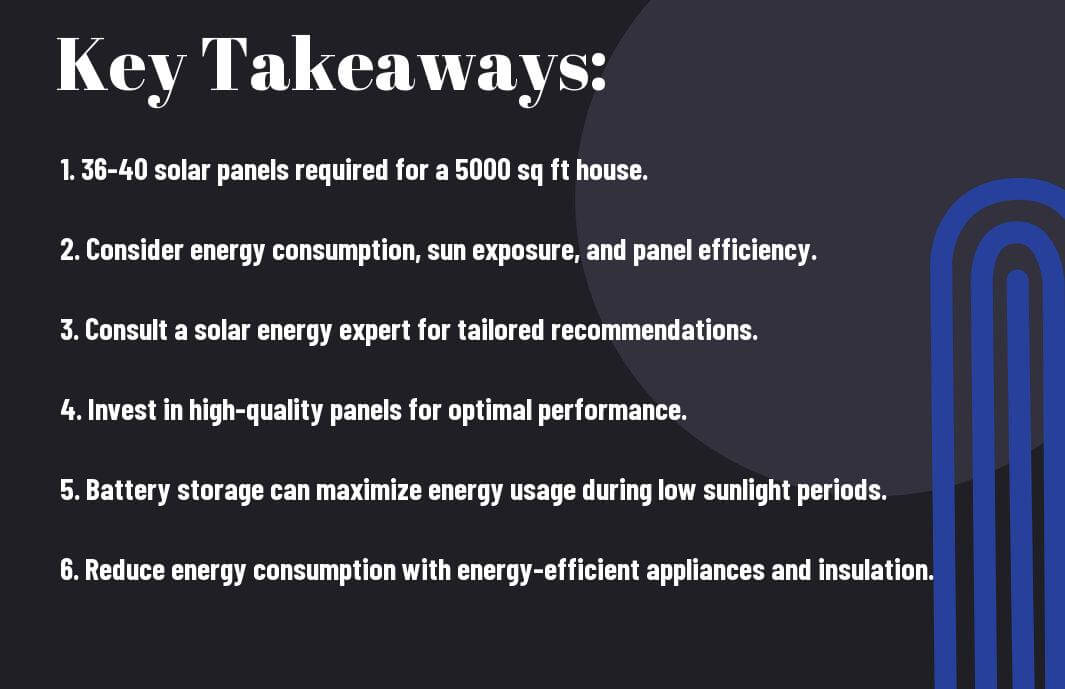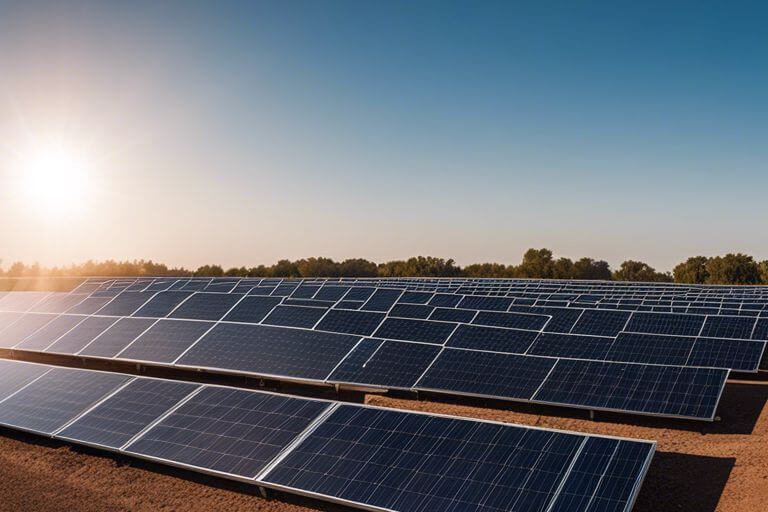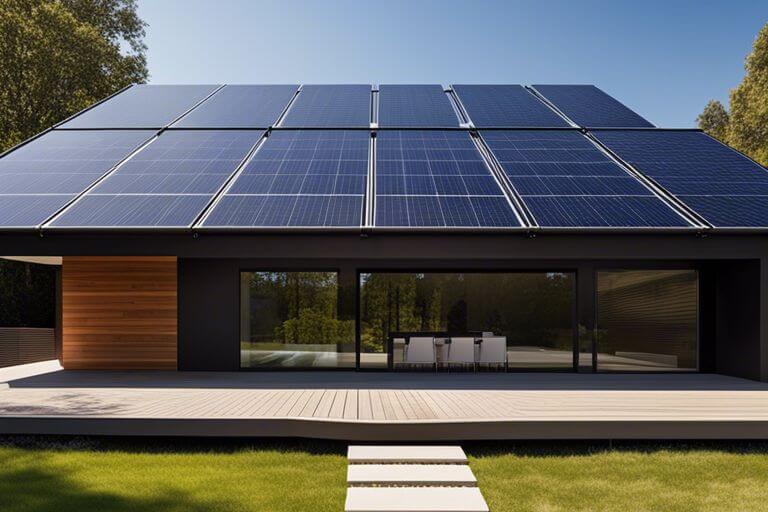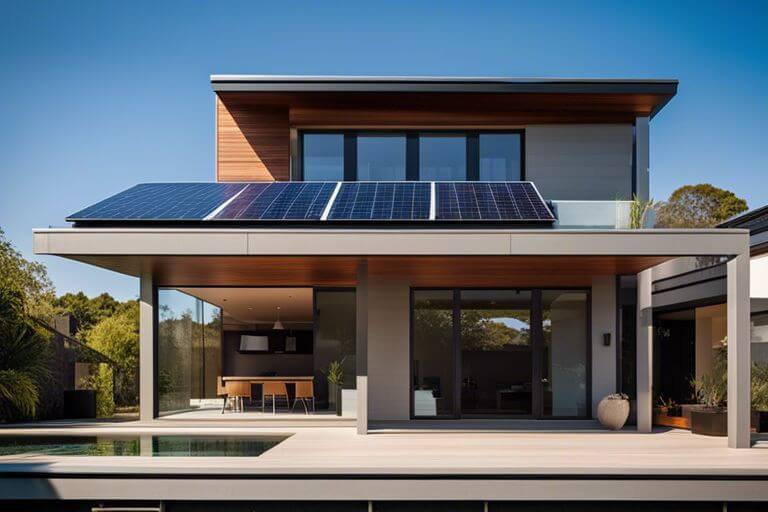Just imagine harnessing the power of the sun to run your 5000 square foot house! In this informative guide, you will discover how many solar panels you need to achieve this sustainable goal. By the end, you will have a clear idea of the number of solar panels required to power your home efficiently while reducing your carbon footprint. Let’s dive in and explore the world of solar power!
Key Takeaways:
- Sizing: The number of solar panels needed to run a 5000 square foot house will vary based on factors such as energy consumption, location, roof orientation, and panel efficiency.
- Calculations: To determine the exact number of panels required, you can use the average energy consumption of the house, the peak sun hours in your area, and the wattage of the solar panels.
- Consultation: It is recommended to consult with a professional solar installer to assess your specific energy needs and design a customized solar panel system for your 5000 square foot house.


Determining Your Energy Needs
Calculating Your Energy Consumption
Your first step in determining how many solar panels you need to run a 5000 square foot house is to calculate your energy consumption. Start by looking at your past utility bills to determine your average monthly kilowatt-hour (kWh) usage. This will give you an idea of how much energy your household consumes on a regular basis. You can also use online tools and calculators to help you estimate your energy needs based on the size of your home and the appliances you use.
Factors Affecting Energy Usage
Usage habits and the energy efficiency of your appliances are key factors that can affect your energy consumption. For example, running multiple high-energy appliances simultaneously, such as air conditioners, heaters, and electric stoves, can significantly increase your energy usage. Similarly, using energy-efficient appliances and practicing energy-saving habits, like turning off lights when not in use and properly insulating your home, can help reduce your overall energy consumption. Therefore, being mindful of how you use energy in your home can have a big impact on the number of solar panels you will need to power your 5000 square foot house.
- Installing energy-efficient appliances and lighting can help reduce energy consumption
- Proper insulation and sealing of windows and doors can prevent energy wastage
More About Factors Affecting Energy Usage
Factors such as the number of occupants in your home, the climate in your area, and even the orientation of your house can also influence your energy usage. For instance, a household with more occupants will likely use more energy for heating water and running appliances. Additionally, if you live in a region with extreme temperatures, you may need more energy to heat or cool your home. Properly positioning your solar panels to capture the most sunlight throughout the day can also affect the efficiency of your solar power system.
- Using natural light during the day can reduce the need for artificial lighting
- Regular maintenance of appliances can improve their energy efficiency
Energy
Energy consumption can vary significantly based on the time of year and your daily activities. During summer months, for example, you may use more energy to cool your home, while in winter, heating systems may be the primary energy draw. Understanding your energy usage patterns can help you plan for the appropriate number of solar panels to meet your energy needs. By analyzing your habits and making conscious choices to reduce energy waste, you can optimize the efficiency of your solar power system and minimize the number of panels required.

Assessing Your Roof’s Potential
Roof Size and Orientation
Any solar panel installation begins with an assessment of your roof’s size and orientation. The amount of available sunlight your roof receives is critical for generating solar power efficiently. A 5000 square foot house is sizable, so you may have ample roof space to accommodate the number of solar panels needed for your energy requirements. Additionally, it’s imperative to consider the orientation of your roof. South-facing roofs receive the most sunlight throughout the day, making them ideal for solar panel installations.
Shading and Obstructions
One crucial factor to evaluate is the shading and potential obstructions on your roof. Trees, nearby buildings, or even vents and chimneys can cast shadows on your roof, reducing the effectiveness of your solar panels. It’s important to assess the shading patterns throughout the day to determine the best spots for installing solar panels. Choosing a location on your roof with minimal shading will ensure maximum sunlight exposure and optimal energy production.
The presence of shade or obstructions can significantly impact the efficiency of your solar panel system. Even small amounts of shading can lead to a decrease in energy production. To mitigate this, you may need to trim trees or consider alternative locations for solar panel placement to avoid shading issues.
The size and orientation of your roof, along with potential shading and obstructions, are crucial factors to consider when determining the number of solar panels needed to power a 5000 square foot house. By carefully assessing your roof’s potential, you can optimize your solar panel installation for maximum energy efficiency.
Choosing the Right Solar Panel System
Keep in mind that when choosing the right solar panel system for your 5000 square foot house, there are a few key factors to consider. Finding the perfect fit for your energy needs will ensure that you maximize the benefits of solar power while reducing your carbon footprint. Let’s investigate into the different aspects you should consider when selecting the ideal solar panel system for your home.
Types of Solar Panels
When considering choosing the right solar panels for your home, you have a few different options to consider. The most common types of solar panels used for residential installations are monocrystalline, polycrystalline, and thin-film solar panels. Each type has its own advantages and disadvantages, so it’s important to weigh them carefully before making a decision. Here is a breakdown of the different types of solar panels:
- Panel Type
- Efficiency
- Cost
- Appearance
- Lifespan
Though all solar panels are designed to harness the sun’s energy and convert it into electricity for your home, the specific characteristics of each panel type can impact your overall energy production and long-term savings. Consider your budget, energy needs, and aesthetic preferences when choosing the right solar panel for your 5000 square foot house.
System Size and Configuration
Solar panel systems come in various sizes and configurations, depending on how much energy you need to power your 5000 square foot house. The size of your solar panel system is determined by factors such as your average energy consumption, the amount of sunlight your location receives, and the efficiency of the solar panels you choose.
When designing the configuration of your solar panel system, you can opt for a rooftop installation, ground-mounted system, or even solar shingles that blend seamlessly with your roof. Your choice of system size and configuration will impact how much electricity your solar panels can generate and how effectively they can meet your household’s energy demands.
Sizing Your Solar Panel System
Calculating the Required System Size
All you need to calculate the number of solar panels required to power your 5000 square foot house is to consider your average daily energy usage. With this information, you can determine the number of kilowatt-hours (kWh) your household consumes per day. By factoring in the average peak sunlight hours in your location, you can then calculate the size of the solar panel system needed to meet your energy needs.
Considering Energy Efficiency Upgrades
Considering energy efficiency upgrades for your home can significantly impact the number of solar panels you need. By making simple changes such as switching to energy-efficient appliances, improving insulation, or upgrading to LED lighting, you can reduce your overall energy consumption. This means you may require fewer solar panels to power your 5000 square foot house, ultimately saving you money in the long run.
Your energy efficiency upgrades will not only lower your electricity bill but also reduce the environmental impact of your home. Making these changes will not only benefit you financially but also contribute to a more sustainable future for our planet.
Installation and Maintenance Considerations
Installation Requirements and Costs
Many factors come into play when determining the installation requirements and costs for solar panels to power a 5000 square foot house. The size of your roof, the angle and orientation of your panels, and the local climate conditions all play a role in determining how many panels you’ll need. Additionally, you’ll need to consider the cost of equipment such as inverters, wiring, and mounting hardware.
It’s also important to factor in the installation costs, which can vary depending on your location and the complexity of your solar panel system. Hiring a professional installer can ensure that your panels are set up correctly and efficiently, saving you time and potential headaches in the long run.
Ongoing Maintenance and Repair
Considerations for ongoing maintenance and repair of your solar panel system are crucial to ensure optimal performance. You will need to regularly clean the panels to remove dirt, dust, and debris that can hinder their efficiency. Additionally, you may need to replace certain parts over time, such as the inverter or wiring, to keep your system running smoothly.
Regular inspections by a professional can help identify any issues early on and prevent larger problems from occurring. By investing in routine maintenance, you can extend the lifespan of your solar panel system and maximize your energy savings in the long term.
Costs
It’s imperative to budget for both the upfront installation costs and ongoing maintenance expenses when considering solar panels for your 5000 square foot house. While the initial investment may seem daunting, the long-term savings on your energy bills and potential tax incentives can make solar power a cost-effective choice for powering your home. By carefully planning for installation and maintenance costs, you can enjoy the benefits of clean, renewable energy for years to come.
Evaluating Your Budget and Incentives
Initial Investment and Payback Period
One of the first things you need to consider when determining how many solar panels you need to run a 5000 square foot house is your initial investment and the payback period. Installing a solar system can be a significant upfront cost, but it’s imperative to look at the long-term savings. By analyzing your energy consumption and the potential output of the solar panels, you can estimate how long it will take for the system to pay for itself through energy savings. This payback period is crucial for understanding the financial impact of your solar investment.
Government Incentives and Rebates
Initial research is key to uncovering the various government incentives and rebates that can help offset the initial cost of installing solar panels on your 5000 square foot house. These incentives can significantly reduce the overall cost of your solar system, making it more affordable for you. Government programs can vary by location, so it’s imperative to check what options are available in your area. Incentives like tax credits, rebates, and net metering programs can all contribute to making your solar investment more financially feasible.
Plus, going solar not only benefits you financially in the long run but also helps reduce your carbon footprint and contribute to a cleaner, more sustainable environment. Taking advantage of government incentives and rebates not only makes financial sense but also aligns with your commitment to environmental responsibility.
Summing up
Hence, when determining how many solar panels you need to run a 5000 square foot house, it is crucial to consider various factors including location, energy consumption, panel efficiency, and sunlight exposure. By calculating your daily energy usage and determining the energy output of each solar panel in your area, you can arrive at the number of panels required to meet your needs. It is recommended to consult with a professional to ensure you get the most efficient solar system for your home.
Q: How many solar panels do I need to run a 5000 square foot house?
A: The number of solar panels needed to power a 5000 square foot house depends on several factors, including the energy consumption of the household, the efficiency of the solar panels, and the amount of sunlight the location receives. On average, a 5000 square foot house may require between 25 to 40 solar panels.
Q: What factors should I consider when determining the number of solar panels for a 5000 square foot house?
A: When calculating the number of solar panels needed for a 5000 square foot house, consider the average daily energy consumption, the peak sunlight hours in your area, the efficiency of the solar panels, the orientation and tilt of the panels, and any shading that may affect the panels’ performance.
Q: How can I determine the exact number of solar panels required for my 5000 square foot house?
A: To determine the exact number of solar panels needed to power a 5000 square foot house, it is recommended to consult with a solar energy expert or installer. They can conduct an on-site evaluation, consider your energy needs and goals, and provide a customized solar panel system design that is tailored to your specific requirements.
